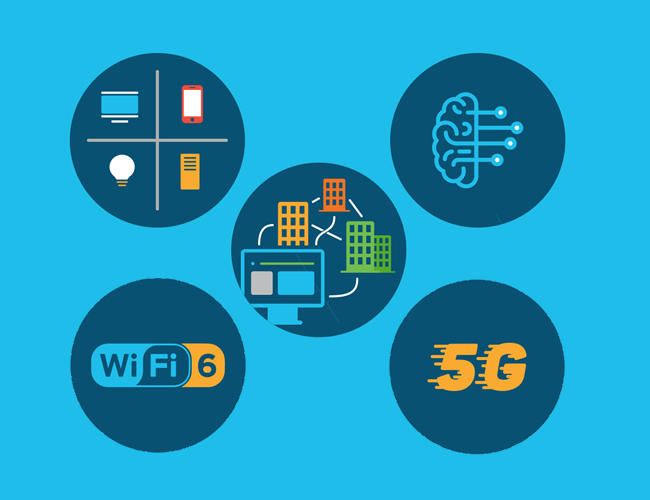The networking field is changing fast. This year, several emerging technologies will fundamentally impact how businesses and their employees connect. The good news is that each technology also represents a solid opportunity to improve some aspect of how a company runs – from network efficiency all the way up to business models.

Wi-Fi 6
The Win: Wireless Density
The Winners: Office networking, IoT
When: Prep and first rollout in 2019, broad adoption in 2020
Wi-Fi 6, also called 802.11ax, is an upgrade on the current highest-speed Wi-Fi protocol in wide use, 802.11ac. Wi-Fi 6 brings a dramatic improvement in efficiency across all existing Wi-Fi bands, including older 2.4GHz frequencies. Wi-Fi 6 will also likely get new spectrum in the 6GHz band in 2019 or 2020, further improving its speed.
The biggest improvement that comes with Wi-Fi 6 is that it increases the densityof devices that can co-exist in a single space, further increasing the speed of all devices when there is more than one.
The new standard also improves performance by supporting deterministic (that is, not random) packet scheduling, which, as well as increasing the efficiency of the use of any given band, also makes for dramatic improvements in power utilization by mobile devices.
Wi-Fi 6 will eventually improve the experience for almost all wireless users, from office workers, who will find that their devices communicate more reliably and quickly in crowded offices, to people supporting constellations of IoT devices, who will find that they can pack more low-power devices into a space with fewer access points. The reliably deterministic nature of Wi-Fi 6, combined with its speed, means it should be usable for life-safety applications, including things like remote surgery devices.
Wi-Fi 6products will begin rolling out in 2019.
5G
The Win: High-speed networking everywhere
The Winners: Businesses with remote workforces, automotive industry
When: Planning this year, rollout in 1-3 years
Consumers will be itching to get onboard with 5G in 2019, as carriers roll out limited installations that work on a small number of devices. Beyond 2019, 5G will bring improved speed and battery life to smartphones, as well as the growth of fixed wireless for residences, competing with wired broadband for some communities.
In the enterprise, the impact of 5G in 2019 (and beyond) will be more nuanced, but it will be felt.
5G fixed wireless will be a convenient option as a WAN connection for getting branch offices online. It may have the performance (high speed and low latency) to compete with wired connections.
As 5G rolls out (which will take years), it will also open up new possibilities for IoT applications. Thanks to 5G’s time-slicing technology, sensors will able to run on batteries that last for years.
5G’s wireless technology will also make it into corporate local-area networks: An extension of the licensed 5G spectrum into a new, lightly-licensed band, CBRS (Citizens Broadband Radio Service), will allow businesses to set up their own, completely private 5G data networks. For some IoT installations, this could be a compelling solution.
Wi-Fi 6 and 5G will coexist as critical wireless technologies for the enterprise. It will, however, be a challenge at first to find ways to manage networks as users and devices move between them. The two technologies are highly complementary, and will be even more so when network management tools evolve to handle them side-by-side.
Digitized Spaces
The Win: Deep business insights and analytics
The Winners: Business leaders, startups
When: Now
New high-resolution geolocation technologies based on wireless radios in mobile devices, plus data mining software, are creating opportunities to understand how people and things move through physical spaces. Companies that adopt these technologies will get access to information about the users of their buildings that will open up new possibilities for business extensions and improvements.
Any business with customers at its sites (retail, education, medical, hospitality) will be able to see not just which spaces are used, but when and by what type of customer. For example, a retailer might be able to tell precisely when recipients of a coupon visit a store. A hotelier could tell if loyalty card members are using the health club. Educators would be able to track patterns in teaching spaces.
Additionally, digitized spaces will help network managers. They’ll be able to identify areas where wireless service is weak, allowing highly precise deployment of new access points. And in security, it will be easier for analytics engines to notice unusual patterns of movement among wireless devices that could indicate physical beaches.
SD-WAN
The Win: Robust, agile, and secure large-scale networks
The Winners: IT leaders, business planners
When: Now
Traditionally, corporate networks have been based around centralized control, routing, and security. Nearly all network traffic in a large business would be back-hauled to a main data center, where the interconnects to other branches and systems were, and where the security applications like firewalls did their work.
That model still exists – businesses don’t change network architectures rapidly – but it is breaking down. Designing networks primarily around branch-to-data-center connections doesn’t make sense when so many business applications are now run out of the cloud, and so many end users rely on the open Internet for connection when they’re not in a company office.
For these and other reasons, business are moving to software-defined wide-area networking, SD-WAN. SD-WAN allows networks to route traffic based on centrally-managed roles and rules, no matter what the entry and exit points of the traffic is – and with full security. For example, if a user in a branch office is working on Office365, SD-WAN can route their traffic directly to the closest cloud data center for that app, improving network responsiveness for the user and lowering bandwidth costs for the business.
SD-WAN networks can be run by leaner teams of networking engineers, and it is easy for these teams to modify the rules as business needs change. Ultimately, SD-WAN will make it easier for machine intelligence to take a hand in network management, further lowering bandwidth expenses and improving security.
SD-WAN has been a promised technology for years, but in 2019 it will be a major driver in how networks are built and re-built. In the coming year, SD-WAN network traffic will grow by 500%, and our research shows that more than half of business customers who don’t currently use SD-WAN are going to make plans for its adoption.
Machine Learning
The Win: Much more effective networking management
The Winners: IT Managers, planners, and the bottom line
When: This year
Managing a modern network requires deep insights into how all its different pieces work in concert – and often rapid reactions to quickly-changing conditions that are unique to every network. In other words, understanding a network’s health takes pattern-recognition skills.
In 2019, companies will start to adopt Artificial Intelligence, in particular Machine Learning, to analyze the telemetry coming off networks to see these patterns, in an attempt to get ahead of issues from performance optimization, to financial efficiency, to security. The pattern-matching capabilities of ML will be used to spot anomalies in network behavior that might otherwise be missed, while also de-prioritizing alerts that otherwise nag network operators but that aren’t critical. Just as we instinctively know which of the little aches we feel in our bodies are new and which are just part of being who we are, networks will get to know themselves and be able to flag the appropriate issues.
We will also start to use these tools to categorize and cluster device and user types, which can help us create profiles for use cases as well as spot outlier activities that could indicate security incursions. IT operators may also enjoy being able to converse with their management tools more naturally.
The first application of AI in network management will be simply reporting on activities that break patterns. In other words, smarter alerts. As the technology advances, the tech will grow to be proactive. It will be able to react to more situations autonomously. Workable tools for this should appear later in 2019.
A Leap Forward
2019 is going to be a transformative year in enterprise networking. Network operators will be preparing systems to support dramatically greater device density and data throughput, and they will be getting new analytics about their infrastructure use from the network itself. Meanwhile, network personnel will become more effective and efficient, thanks to improvements in centralized management tools and machine intelligence.
Together, these new capabilities will make networks into even more important assets that businesses will leverage in ways that we have not yet begun to realize.
 IT Network Equipment Supplier
IT Network Equipment Supplier
